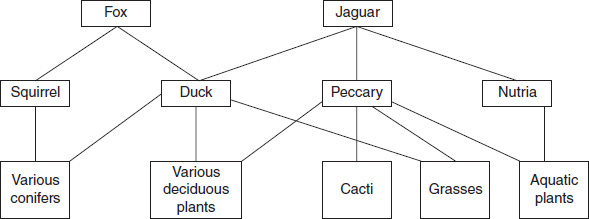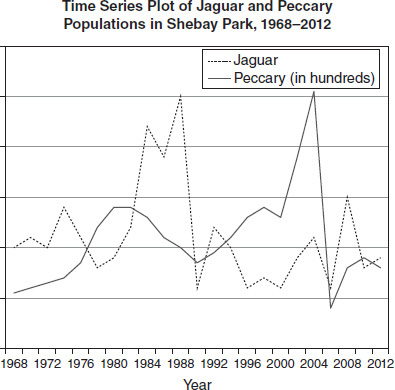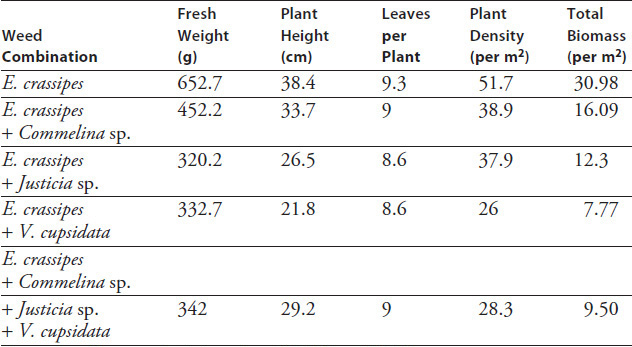
ACT Science Practice Test 18
Đề thi nằm trong bộ sưu tập: Tuyển Tập Bộ Đề Thi Đại Học Hoa Kỳ (ACT) - Có Đáp Án Chi Tiết
Số câu hỏi: 26 câuSố mã đề: 1 đềThời gian: 1 giờ
219,251 lượt xem 16,860 lượt làm bài
Xem trước nội dung:
Shebay Park has been the site of ongoing population dynamics studies since the 1960s. Consisting of a group of isolated islands, the park provides ecologists with a unique, closed ecosystem in which to analyze the relationship between predator and prey populations. Figure 4.5 illustrates the food web for the Shebay Park ecosystem.

Figure 4.5
Ecological research in the park has focused mainly on the predator-prey relationship between the jaguar and peccary (a type of pig) populations. In addition to the typical selective pressures each species exerts on the other, scientists have observed specific events over the years that have affected population sizes. The inadvertent introduction of feline leukemia by humans in the late 1980s severely reduced the jaguar population. In 2004, the severest winter on record and an outbreak of ticks did the same to the peccary population. Figure 4.6 compares the annual population sizes for both species observed between 1968 and 2012.

Figure 4.6
Shebay Park is considered a closed ecosystem because:
organisms cannot easily migrate in from other ecosystems.
population sizes within the ecosystem do not fluctuate.
scientists have never had the opportunity to study the ecosystem.
predator-prey is the only type of relationship that exists in the ecosystem.
According to the food web in Figure 4.5, peccary can be categorized as which type of consumer?
Scavengers
Herbivores
Carnivores
Omnivores
According to Figure 4.6, what has been the maximum size of the jaguar population since 1968?
20
60
50
10
The peccary population reached its smallest size in which year?
2006
2003
1995
1988
It can be inferred that the 13-year trend in the peccary population that began after 1990 was largely influenced by a sharp decline in:
the jaguar population caused by disease.
cactus growth caused by disease.
the jaguar population during a severe winter.
cactus growth during a severe winter.
According to Figure 4.5, how many secondary consumer species are present in the Shebay Park ecosystem?
0
1
6
2
Organisms that compete for many of the same resources within an ecosystem are said to occupy similar niches. Based on the information in Figure 4.5, which populations occupy a niche most similar to that of the peccary population?
Nutria and squirrel
Fox and jaguar
Duck and fox
Nutria and duck
Based on the data in Figure 4.6, a sharp decline in a population's size most commonly occurs in response to:
a sharp increase in another population's size.
an event that reduces individuals' immediate survival.
a parallel decline in the size of other populations.
an event that limits individuals' reproductive ability.
Ecologists believe that an increase in parasites is partially responsible for the shift in:
the peccary population after 2004.
the peccary population before 2004.
the jaguar population after 1990.
the jaguar population before 1990.
Which of the following statements is best supported by the information in the passage?
Predation is the single greatest factor affecting peccary population size.
Food availability is the single greatest factor affecting peccary population size.
Peccary population size varies independently of the predator population size.
Predation is one of several factors that impact the size of the peccary population.
Based on Figure 4.5, which population is least likely to be affected by a change in the peccary population?
Aquatic plants
Squirrel
Cacti
Duck
An invasive species is a species that is not native to an ecosystem and whose introduction has harmful environmental, economic, and/or human health effects.
Eichhornia crassipes (water hyacinth) is an invasive species of floating aquatic weed found in freshwater waterways in tropical and temperate regions worldwide. It is highly tolerant of fluctuations in water level, nutrient availability, pH, and temperature. This allows it to grow rapidly and outcompete native aquatic plant species for resources. Dense floating mats of E. crassipes further alter aquatic communities by reducing dissolved oxygen levels and access to light. Decomposing matter from E. crassipes mats increases sediment deposition in waterways.
Ecological studies have shown that the growth of a plant can be influenced by competition with different species of neighboring plants. A group of scientists carried out the following studies to determine the effects on the growth of E. crassipes when paired with three other, more benign, aquatic weed species.
Study 1
Scientists collected growth data on E. crassipes mats in the Kagera River in Tanzania. Scientists marked off 1 square meter (m2) sample areas containing E. crassipes alone and in combination with three other aquatic weeds common to the Kagera River.
To determine the effects of the other three weed species on E. crassipes growth, scientists analyzed five growth parameters. Fresh weight was determined by removing and immediately weighing 10 E. crassipes plants from each area. Plant height was measured from the base of the plant to the tip of the tallest leaf. The total number of E. crassipes plants within a sample area was recorded as plant density, which was then multiplied by fresh weight to determine total biomass. The number of leaves per plant was also recorded. Table 5.1 lists the averages for each growth parameter for E. crassipes growing alone and in combination with the three other aquatic weed species.
TABLE 5.1 Kagera River Data

Source: http://www.academicjournals.org/ijbc/fulltext/2011/August/Katagira%20et%20al.htm.
Study 2
Scientists transplanted young E. crassipes, Commelina sp., Justicia sp., and V. cupsidata plants from the Kagera River to a greenhouse. In the greenhouse, E. crassipes potted alone and in combination with the other three weed species were allowed to grow in water from the Kagera River for four months. At the end of the four-month growth period, the parameters of fresh weight, plant height, and leaves per plant were all determined by the same methods used in Study 1.
Table 5.2 lists the averages for each growth parameter for E. crassipes growing in the greenhouse alone and in combination with the other aquatic weed species.
TABLE 5.2 Greenhouse Experiment Data

Source: http://www.academicjournals.org/ijbc/fulltext/2011/August/Katagira%20et%20al.htm.
According to the passage, species identified as invasive are always:
aggressively growing plants.
disruptive to an ecosystem.
introduced by humans.
economically profitable.
According to the passage, water hyacinths upset freshwater ecosystems by doing all of the following except:
increasing sediment deposition in waterways.
outcompeting native plants for resources.
altering the pH of aquatic environments.
limiting aquatic organisms' access to sunlight.
Which weed combination was tested in Study 1 but not Study 2?
Water hyacinth alone
All four aquatic weeds together
Water hyacinth with cupsidata
Water hyacinth with Justicia
In Study 1, plant density was measured as:
the total number of crassipes2
the total number of weed plants in 1 m2
fresh weight divided by water volume in 1 m2
fresh weight divided by plant volume in 1 m2
Which weed combination serves as the control group in Study 1?
In Study 1, V. cupsidata caused the greatest reduction in:
all crassipes
all growth parameters except fresh weight.
Based on the data in Table 5.1, which weed exerts the least competitive pressure on E. crassipes?
The combination of all three weeds.
In Table 5.2, Commelina sp. and Justicia sp. are both shown to have:
a stronger effect on fresh weight than cupsidata
no effect on crassipes
the same effect on fresh weight as cupsidata
a positive effect on crassipes
In Study 2, the water hyacinths grown alone exhibited a greater average:
number of leaves than in Study 1.
plant height than in Study 1.
fresh weight than in Study 1.
total biomass than in Study 1.
Total biomass was not included as a growth parameter in Table 5.2 because:
plant density was not measured in Study 2.
the fresh weight values recorded in Table 5.2 were too low.
the plants used in Study 2 had no biomass.
total biomass is not a good indicator of plant growth.
Which of the following statements is supported by the data collected in both studies?
Water hyacinth growth is not affected by the presence of other weed species.
Based on the data in Table 5.2, the most significant impact of growing E. crassipes in combination with other weeds in a greenhouse environment appears to be the production of:
shorter plants.
lighter plants.
fewer leaves per plant.
fewer plants.
The greatest advantage of the experimental design in Study 2 is that scientists were able to:
choose on which weed species to focus their observations.
record data more frequently than could be done at the Kagera River.
control for other environmental factors that may affect plant growth.
obtain more precise measurements for each of the growth parameters.
According to Table 5.1, the presence of all three competitor weeds within the same square meter appears to have:
a greater effect on crassipes
an effect approximately equal to the sum of the effects of each single competitor weed on fresh weight.
a lesser effect on crassipes
an effect approximately equal to the mean of the effects of each single competitor weed on fresh weight.
Ecologists have found that introducing a competitor to an ecosystem is sometimes more effective in reducing an unwanted population than introducing a predator. Based on the results of this pair of studies, increasing the presence of which of the following species can be predicted to best reduce the water hyacinth population?
